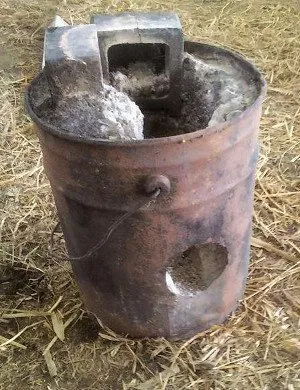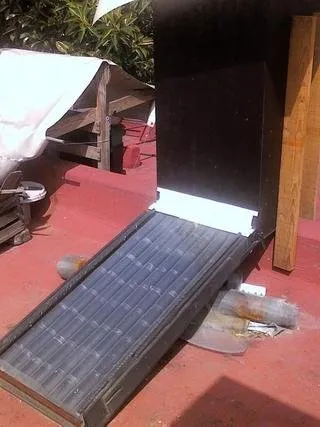Heat rises, and nature avoids a vacuum. These two simple premises can open up a wide plethora of useful applications, if we know how to use them. In today’s post I’d like illustrate this passive, but highly efficient method, which in my opinion is extremely underutilized, for our otherwise technologically advanced culture. I’m not even sure why that is. It could be that convection is too simple, too passive, making inventors and innovators feel useless. Whatever the case, some people have learned to use convection for their benefits, with some amazing results.
The Kelly Kettle, a Rocket Water Kettle

Probably the simplest way to illustrate convection in practice, is the Kelly Kettle. Invented by ingenious Irish solders in WWI, this rocket water heater consists of a base for lighting a small fire, and a vertical tube placed over it. Around the tube is the container for about one liter of water. Acting as a chimney, the vertical tube maximizes the flow of hot air upwards, while giving a good strong draw to the fire through the hole on the side of the base. As a result the fire burns fast and hot, using up all the fuel very efficiently, so even thin pieces of wood, or even straw, will be sufficient to heat the water inside the kettle. When feeding our caffeine addictions in the morning, we used to heat water in two kettles at the same time: one liter in the Kelly Kettle, and one liter in a conventional stove-top kettle on a gas flame. Though close in time, the Kelly Kettle had the water boiling before the kettle on the gas stove started whistling.
Taking It a Step Further – The Horno Chileno and the Lorena Stove

Since convection works so beautifully for a liter of water, why not apply the same principle for stoves and ovens? The kitchen on the Chinampa Tlicuili uses a rocket stove called the Lorena, and the so called Horno Chileno, or Chilenian Oven, based on the same principle of convection. In fact, even the seemingly primitive predecessor of the Lorena was a rocket stove: A shoddy, rusted through metal bucket, filled with “superadobe” (that is dirt and some leftover cement), and some flat pieces of rubble the pot could sit on. Through a strategically placed horizontal opening on the lower side the air could flow upwards and out the big opening on the top. Not necessarily pretty, but it worked like a charm.
Once the kitchen structure was built, a bigger, nicer, more permanent stove was called for. Enter the Lorena. Under the large square metal tray serving as a stove-top, it is the same convection that would make it work: The air enters through the same hole on the left, used for feeding the fire. The chimney in the right rear corner draws it along the bricks, providing constant heat. Therefor the left side of the stove has a higher heat, which can burn down quickly, whereas the right side would offer a more constant heat. As for the Horno Chileno, the principle is the same: the air is drawn through the bottom hole, around the drum, and up through the chimney. Inside the bricks offer a flat surface and additional thermal mass for the heat.




Heating the Home Using Convection
Many who are familiar with rocket stoves, would probably continue now with the next logical step: rocket mass heaters. And they are right, when it comes to fuel efficiency and providing a cozy, constant warmth in harsh winter climates, there is hardly anything that could beat a rocket mass heater. In Mexico where I am, however, there really is no need for such contraptions. Instead, the passive solar energy is more than enough, if it is properly used.
The most effective way I have seen of using convection passively is in Earthships, although the idea itself is ancient, and examples can be seen all throughout North African and Middle Eastern architecture: Cooling tubes / ducts / vents / or simply holes draw cool air from outside, usually from the shady northern side of the building, often leading through thick walls, or in the case of Earthships the berm of dirt piled around the structure. The air inside the building heats up and rises, especially with the aid of the greenhouse on the southern side, and as it escapes through the top vent, it draws more cool air through these tubes behind it. This way, the more heat there is, the more cooling circulation is the result, all completely passively, without any moving parts or energy intake.

This same law of convection is the reason why my black tent is the coolest place in the daytime heat, if set up properly. The flaps on the side are folded in, making it look like it’s floating in the air. As the black tarp is heated in the sun, the air inside is heated as well, escaping through the hole in the center, and pulling in more air from around the bottom. As a result there is constant air circulation going on inside, which together with the shade offers a comfortably pleasant place to chill.

Preserving Perishables Using a Solar Dehydrator
Another super useful way to use convection is to dehydrate food. As it may be well known, what really helps the decomposition (rot) of food is its water content. Remove the water, and the fungi and bacteria who would otherwise make it go bad rather quickly, will have a much harder time. Unlike with jam or preserve making, there is no additional sugar involved, leaving the fruit as it is (only smaller and shrively, due to the lack of water). So how can we get the water out of it? By exposing it to a constant flow of air, following the same technique.
My solar dehydrator consists of a simple plywood box with wire-mesh shelves inside, and a home made solar panel, inclined on its south facing side. The panel is made of recycled beer cans with the tops and bottoms cut off so they can slide into each other, forming a tube of about a meter (yard) long. Ten of these tubes are painted black and placed side by side into an insulated frame, covered by a glass panel. This means, outside temperatures don't need to be really hot for the air to circulate. The direct sunlight is enough to warm up the thin black aluminum tubes under the glass pane, so the air inside them can heat up sufficiently to move upwards through the tubes and into the dehydrator box. There it continues passing through the shelves, taking the moisture from the fruit with it, before leaving through the holes on the top of the northern side, which also functions as door.




This is the first solar dehydrator I have built, but I'm certain it won't be the last. Next time I'll substitute the wire mesh with something that doesn't corrode, and I'll make sure to get a better roof for the whole thing. Other than that, I believe such a dehydrator is an essential infrastructure for any place that produces more food that can be eaten at once, which ideally should be the case for any farm or garden. At the same time, I believe this entire concept of heat convection is not utilized enough, giving us a number of good challenges to work on.